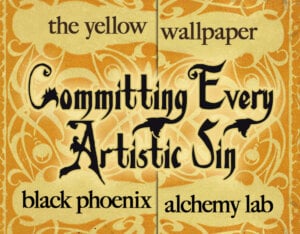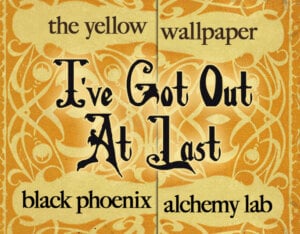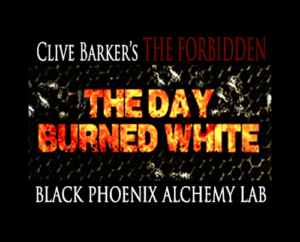Plaster
-
Committing Every Artistic Sin Perfume Oil
Add to cartIt is stripped off—the paper—in great patches all around the head of my bed, about as far as I can reach, and in a great place on the other side of the room low down. I never saw a worse paper in my life.
One of those sprawling flamboyant patterns committing every artistic sin.
It is dull enough to confuse the eye in following, pronounced enough to constantly irritate, and provoke study, and when you follow the lame, uncertain curves for a little distance they suddenly commit suicide—plunge off at outrageous angles, destroy themselves in unheard-of contradictions.
The color is repellant, almost revolting; a smouldering, unclean yellow, strangely faded by the slow-turning sunlight.
It is a dull yet lurid orange in some places, a sickly sulphur tint in others.
No wonder the children hated it! I should hate it myself if I had to live in this room long.
A smouldering, unclean scent: turmeric-dusted acrid marigold, linseed oil, bitter orange peel, crumbling plaster, clotted vanilla, and a whiff of sweet mildew. -
I’ve got out at last Perfume Oil
Add to cartHe stopped short by the door.
“What is the matter?” he cried. “For God’s sake, what are you doing!”
I kept on creeping just the same, but I looked at him over my shoulder.
“I’ve got out at last,” said I, “in spite of you and Jane! And I’ve pulled off most of the paper, so you can’t put me back!”
Now why should that man have fainted? But he did, and right across my path by the wall, so that I had to creep over him every time!
Torn paper revealing scorched plaster embedded with bitter citron, yellow grapefruit, and damp white cedar. -
The Day Burned White Perfume Oil
Add to cartUsing the door, which was centrally placed in the wall like a mouth, the artists had sprayed a single, vast head onto the stripped plaster. The painting was more adroit than most she had seen, rife with detail that lent the image an unsettling veracity. The cheekbones jutting through skin the color of buttermilk; the teeth, sharpened to irregular points, all converging on the door. The sitter’s eyes were, owing to the room’s low ceiling, set mere inches above the upper lip, but this physical adjustment only lent force to the image, giving the impression that he had thrown his head back. Knotted strands of his hair snaked from his scalp across the ceiling. Was it a portrait? There was something naggingly specific in the details of the brows and the lines around the wide mouth; in the careful picturing of those vicious teeth. A nightmare certainly: a facsimile, perhaps, of something from a heroin fugue. Whatever its origins, it was potent. Even the illusion of door-as-mouth worked. The short passageway between living room and bedroom offered a passable throat, with a tattered lamp in lieu of tonsils. Beyond the gullet, the day burned white in the nightmare’s belly. The whole effect brought to mind a ghost train painting. The same heroic deformity, the same unashamed intention to scare. And it worked; she stood in the bedroom almost stupefied by the picture, its red-rimmed eyes fixing her mercilessly.
Plaster and spraypaint, mottled with buttermilk – sweet, chalky, and edging on sickly. White and golden amber beams of daylight pour through the belly of the scent, while oakmoss and Spanish moss add a touch of decay.


